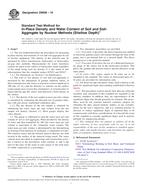Potřebujeme váš souhlas k využití jednotlivých dat, aby se vám mimo jiné mohly ukazovat informace týkající se vašich zájmů. Souhlas udělíte kliknutím na tlačítko „OK“.
ASTM D6035/D6035M-13
Standard Test Method for Determining the Effect of Freeze-Thaw on Hydraulic Conductivity of Compacted or Intact Soil Specimens Using a Flexible Wall Permeameter
Automaticky přeložený název:
Standardní zkušební metoda pro stanovení účinku mrazu na hydraulické vodivosti hutného nebo intaktních půdních vzorků pomocí pružné Wall permeametr
NORMA vydána dne 15.8.2013
Informace o normě:
Označení normy: ASTM D6035/D6035M-13
Poznámka: NEPLATNÁ
Datum vydání normy: 15.8.2013
Kód zboží: NS-33506
Počet stran: 5
Přibližná hmotnost: 15 g (0.03 liber)
Země: Americká technická norma
Kategorie: Technické normy ASTM
Kategorie - podobné normy:
Anotace textu normy ASTM D6035/D6035M-13 :
Keywords:
coefficient of permeability, cover, freeze-thaw, hydraulic conductivity, liner, permeameter, ICS Number Code 13.080.20 (Physical properties of soil)
Doplňující informace
| Significance and Use | ||||||||||||||||
|
4.1 This test method identifies the changes in hydraulic conductivity as a result of freeze-thaw on natural soils only. 4.2 It is the user's responsibility when using this test method to determine the appropriate water content of the laboratory-compacted specimens (that is, dry, wet, or at optimum water content) (Note 2). 4.3 The requestor must provide
information regarding the effective stresses to be applied during
testing, especially for determining the final hydraulic
conductivity. Using high effective stresses (that is, 35 kPa [5
psi] as allowed by Test Method D5084) can decrease an already
increased hydraulic conductivity resulting in lower final hydraulic
conductivity values. The long-term effect of freeze-thaw on the
hydraulic conductivity of compacted soils is unknown. The increased
hydraulic conductivity caused by freeze-thaw may be temporary. For
example, the overburden pressure imparted by the waste placed on a
soil liner in a landfill after being subjected to freeze-thaw may
reduce the size of the cracks and pores that cause the increase in
hydraulic conductivity. It is not known if the pressure would
overcome the macroscopically increased hydraulic conductivity
sufficiently to return the soil to its original hydraulic
conductivity (prior to freeze-thaw). For cases such as landfill
covers, where the overburden pressure is low, the increase in
hydraulic conductivity due to freeze-thaw will likely be permanent.
Thus, the requestor must take the application of the test method
into account when establishing the effective stress.
4.4 The specimen shall be frozen to −15°C [5°F] unless the requestor specifically dictates otherwise. It has been documented in the literature that the initial (that is, 0 to −15°C [32°F to 5°F]) freezing condition causes the most significant effects3 in hydraulic conductivity. Freezing rate and ultimate temperature should mimic the field conditions. It has been shown that superfreezing (that is, freezing the specimen at very cold temperatures and very short time periods) produces erroneous results. 4.5 The thawed specimen temperature and thaw rate shall mimic field conditions. Thawing specimens in an oven (that is, overheating) will produce erroneous results. 4.6 Literature relating to this subject indicates that the effects of freeze-thaw usually occur by Cycle 10, thus it is recommended that at least 10 freeze-thaw cycles shall be performed to ensure that the full effects of freeze-thaw are measured. If the hydraulic conductivity values are still increasing after 10 freeze-thaw cycles, the test method shall be continued (that is, more freeze-thaw cycles shall be performed). 1.1 This test method covers
laboratory measurement of the effect of freeze-thaw on the
hydraulic conductivity of compacted or intact soil specimens using
Test Method D5084 and a flexible wall permeameter to determine
hydraulic conductivity. This test method does not provide steps to
perform sampling of, or testing of, in situ soils that have already
been subjected to freeze-thaw conditions.
1.2 This test method may be used with intact specimens (block or thin-walled) or laboratory compacted specimens and shall be used for soils that have an initial hydraulic conductivity less than or equal to 1E-5 m/s [3.94 E-4 in./s] (1E-3 cm/s) (Note 1). 1.3 Soil specimens tested using this
test method can be subjected to three-dimensional freeze-thaw
(herein referred to as 3-d) or one-dimensional freeze-thaw (herein
referred to as 1-d). (For a discussion of one-dimensional freezing
versus three-dimensional freezing, refer to Zimmie2 or
Othman.1.4 Soil specimens tested using this
test method can be tested in a closed system (that is, no access to
an external supply of water during freezing) or an open system.
1.5 All observed and calculated values shall conform to the guidelines for significant digits and rounding established in Practice D6026. 1.6 The values stated in SI units or inch-pound units (presented in brackets) are to be regarded separately as standard. The values stated in each system may not be exact equivalents; therefore, each system shall be used independently of the other. Combining values from the two systems may result in non-conformance with the standard. Reporting of test results in units other than SI shall not be regarded as conconformance with this test method. 1.7 This standard does not purport to address all of the safety concerns, if any, associated with its use. It is the responsibility of the user of this standard to establish appropriate safety and health practices and determine the applicability of regulatory limitations prior to use. |
||||||||||||||||
| 2. Referenced Documents | ||||||||||||||||
|
Podobné normy:
Historická
1.5.2010
Historická
1.5.2014
Historická
1.7.2011
Historická
15.3.2009
Historická
1.4.2008
Historická
1.11.2008
Doporučujeme:
Aktualizace technických norem
Chcete mít jistotu, že používáte pouze platné technické normy?
Nabízíme Vám řešení, které Vám zajistí měsíční přehled o aktuálnosti norem, které používáte.
Chcete vědět více informací? Podívejte se na tuto stránku.



 ASTM D6938-10
ASTM D6938-10 ASTM D7012-14
ASTM D7012-14 ASTM D7181-11
ASTM D7181-11 ASTM D7263-09
ASTM D7263-09 ASTM D7380-08
ASTM D7380-08 ASTM D7382-08
ASTM D7382-08
 Cookies
Cookies
